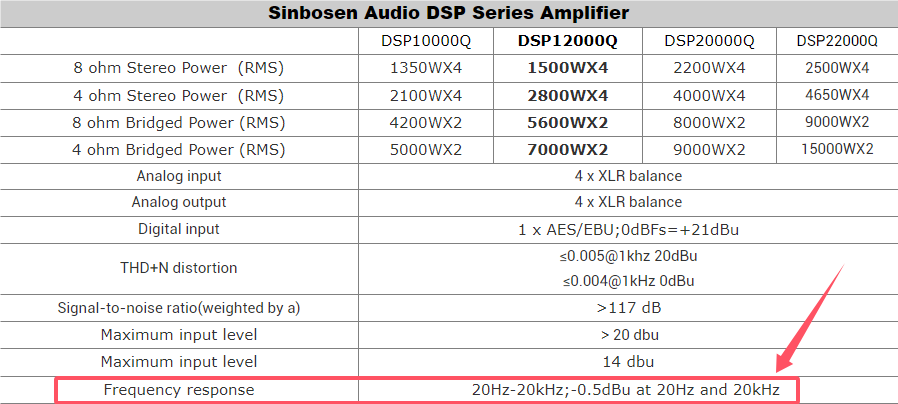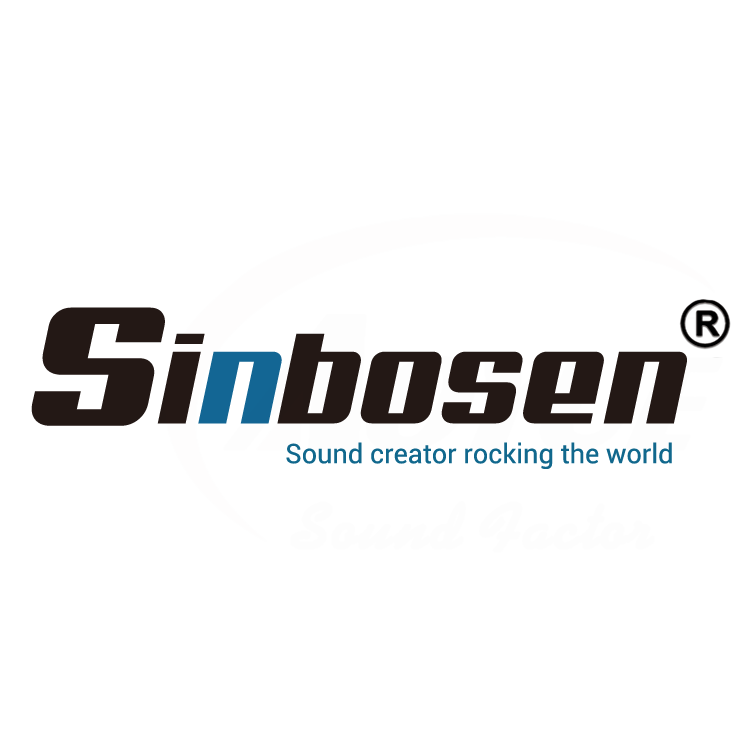Importance of frequency response
Views : 10987
Update time : 2024-08-07 11:43:56
Dear new and old customers of Sinbosen, when you buy an amplifier, you will notice that there is a very important parameter. Yes, it is frequency response.
 Frequency response is a key parameter of a professional amplifier, which indicates the frequency range of sound that the device can effectively amplify. The importance of frequency response is mainly reflected in the following aspects:
Frequency response is a key parameter of a professional amplifier, which indicates the frequency range of sound that the device can effectively amplify. The importance of frequency response is mainly reflected in the following aspects:
1. Sound quality performance
Frequency response directly affects the clarity and accuracy of sound quality. Broad and flat efficiency can ensure that all frequencies of sound (bass, midrange, treble) can be well reproduced, providing more realistic and natural sound effects.
2. Adaptability
Different audio materials (such as music categories, movie sound effects, etc.) have different requirements for frequency response. Amplifiers with good frequency response can better adapt to a variety of applications and meet the needs of professional audio systems.
3. Dynamic range
Good frequency response can enhance the dynamic range of the device, ensure smooth transition between treble and bass, and avoid sound distortion or compression.
4. Speaker matching
The frequency response of the amplifier complements the performance of the connected speakers to ensure the coordination of the overall sound quality of the system. An ideal match can further enhance the expressiveness of the audio.
5. User experience
Music lovers and professional sound engineers are usually highly sensitive to sound quality. Excellent frequency response can provide users with a pleasant listening experience and increase satisfaction with the equipment.
So, some customers may ask how to choose and distinguish the high and low frequency response? This depends on the application scenario and personal needs. Here are some considerations to help you understand the importance of frequency response and make a choice:
1. Wideband response:
A good professional power amplifier should have a wide frequency response range, such as 20Hz to 20kHz. Such a range ensures that both low and high frequencies can be well amplified.
2. Flat frequency response
Within a specific frequency range, the frequency response should be as flat as possible, that is, the gain of different frequencies is basically the same. This means that the power amplifier will not introduce too much color or distortion in certain frequency bands, but can faithfully reproduce the input signal.
3. Low-frequency response
For applications that require heavy bass performance, such as DJ performances, cinema audio, and certain music styles (such as electronic music), low-frequency performance is very important. At this time, you need to pay attention to the performance of the power amplifier in the low frequency range (such as 20Hz to 100Hz).
4. High frequency response
For applications that require delicate treble parts (such as classical music, vocal performances, etc.), high frequency response is particularly important. Make sure that the power amplifier can provide clear and distortion-free output in the high frequency range (such as 10kHz and above).
5. Distortion and sensitivity
When choosing a power amplifier, you also need to pay attention to its total harmonic distortion (THD) and signal-to-noise ratio (SNR). Low distortion ensures that the sound quality is pure at both high and low frequencies, while a higher signal-to-noise ratio means clearer sound quality at all volume levels.
Choosing a suitable professional power amplifier frequency response requires considering the actual use environment, the overall design of the audio system, and personal listening preferences. High and low frequencies are not simply comparable, but need to be balanced and matched to achieve the best audio effect.
The above introduces the importance of the frequency response of the power amplifier, and I hope it will be helpful to you. As a professional amplifier manufacturing brand, Sinbosen covers a full range of amplifier products with various functions, and has amplifiers suitable for various scenarios and situations.
If you need, please contact us!

1. Sound quality performance
Frequency response directly affects the clarity and accuracy of sound quality. Broad and flat efficiency can ensure that all frequencies of sound (bass, midrange, treble) can be well reproduced, providing more realistic and natural sound effects.
2. Adaptability
Different audio materials (such as music categories, movie sound effects, etc.) have different requirements for frequency response. Amplifiers with good frequency response can better adapt to a variety of applications and meet the needs of professional audio systems.
3. Dynamic range
Good frequency response can enhance the dynamic range of the device, ensure smooth transition between treble and bass, and avoid sound distortion or compression.
4. Speaker matching
The frequency response of the amplifier complements the performance of the connected speakers to ensure the coordination of the overall sound quality of the system. An ideal match can further enhance the expressiveness of the audio.
5. User experience
Music lovers and professional sound engineers are usually highly sensitive to sound quality. Excellent frequency response can provide users with a pleasant listening experience and increase satisfaction with the equipment.
So, some customers may ask how to choose and distinguish the high and low frequency response? This depends on the application scenario and personal needs. Here are some considerations to help you understand the importance of frequency response and make a choice:
1. Wideband response:
A good professional power amplifier should have a wide frequency response range, such as 20Hz to 20kHz. Such a range ensures that both low and high frequencies can be well amplified.
2. Flat frequency response
Within a specific frequency range, the frequency response should be as flat as possible, that is, the gain of different frequencies is basically the same. This means that the power amplifier will not introduce too much color or distortion in certain frequency bands, but can faithfully reproduce the input signal.
3. Low-frequency response
For applications that require heavy bass performance, such as DJ performances, cinema audio, and certain music styles (such as electronic music), low-frequency performance is very important. At this time, you need to pay attention to the performance of the power amplifier in the low frequency range (such as 20Hz to 100Hz).
4. High frequency response
For applications that require delicate treble parts (such as classical music, vocal performances, etc.), high frequency response is particularly important. Make sure that the power amplifier can provide clear and distortion-free output in the high frequency range (such as 10kHz and above).
5. Distortion and sensitivity
When choosing a power amplifier, you also need to pay attention to its total harmonic distortion (THD) and signal-to-noise ratio (SNR). Low distortion ensures that the sound quality is pure at both high and low frequencies, while a higher signal-to-noise ratio means clearer sound quality at all volume levels.
Choosing a suitable professional power amplifier frequency response requires considering the actual use environment, the overall design of the audio system, and personal listening preferences. High and low frequencies are not simply comparable, but need to be balanced and matched to achieve the best audio effect.
The above introduces the importance of the frequency response of the power amplifier, and I hope it will be helpful to you. As a professional amplifier manufacturing brand, Sinbosen covers a full range of amplifier products with various functions, and has amplifiers suitable for various scenarios and situations.
If you need, please contact us!
Contact us:
 sales2@sinbosen.com
sales2@sinbosen.com
Whatsapp:https://api.whatsapp.com/send?l=en&phnoe=8616676738225
Website:https://www.sinbosenaudio.com/
Whatsapp:https://api.whatsapp.com/send?l=en&phnoe=8616676738225
Website:https://www.sinbosenaudio.com/










